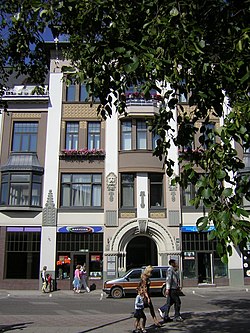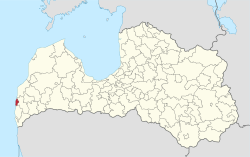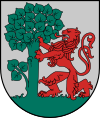Libava
| Liepāja | |||
|---|---|---|---|
| City | |||

Art Nouveau architecture in Liepāja.
|
|||
|
|||
 Location of Liepāja within Latvia |
|||
| Coordinates: 56°30′42″N 21°00′50″E / 56.51167°N 21.01389°ECoordinates: 56°30′42″N 21°00′50″E / 56.51167°N 21.01389°E | |||
| Country |
|
||
| Town rights | 1625 | ||
| Government | |||
| • Mayor | Uldis Sesks | ||
| Area | |||
| • Total | 60.4 km2 (23.3 sq mi) | ||
| • Water | 10.87 km2 (4.20 sq mi) | ||
| Population | |||
| • Total | 82,386 | ||
| • Density | 1,398/km2 (3,620/sq mi) | ||
| Time zone | EET (UTC+2) | ||
| • Summer (DST) | EEST (UTC+3) | ||
| Postal code | LV-34(01-13); LV-3414; LV-34(16–17) | ||
| Calling code | +371 634 | ||
| Number of city council members | 15 | ||
Liepāja (pronounced [liepaːja]); German: Libau, Lithuanian: Liepoja, Polish: Lipawa, Yiddish: ליבאַװע Libave) is a city in western Latvia, located on the Baltic Sea directly at 21°E. It is the largest city in the Kurzeme Region and the third largest city in the country after Riga and Daugavpils. An important ice-free port, as of 1 July 2011, Liepāja had a population of 83500.
Liepāja is known throughout Latvia as "City where the wind is born", likely because of the constant sea breeze. A song of the same name (Latvian: "Pilsētā, kurā piedzimst vējš") was composed by Imants Kalniņš and has become the anthem of the city. Its reputation as the windiest city in Latvia was strengthened with the construction of the largest wind farm in the nation (33 Enercon wind turbines) nearby.
The Coat of Arms of Liepāja was adopted four days after the jurisdiction gained city rights on 18 March 1625. These are described as: "on a silver background, the lion of Courland with a divided tail, who leans upon a linden (Latvian: Liepa) tree with its forelegs." The flag of Liepāja has the coat of arms in the center, with red in the top half and green in the bottom.
The original settlement at the location of modern Liepāja was founded by Curonian fishermen from Piemare, and was known by the name Līva (from the name of the river Līva on which Liepāja was located. The name was derived from the Livonian word Liiv meaning "sand"). The oldest written text mentioning the name is dated 4 April 1253. The Livonian Order, under the aegis of the Teutonic Order, established the settlement as the village of Liba(u) in 1263. In 1418 the city was sacked and burned by the Lithuanians.
...
Wikipedia


